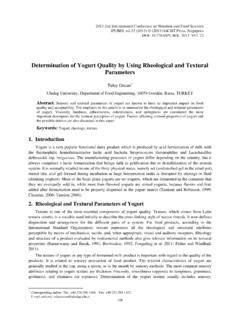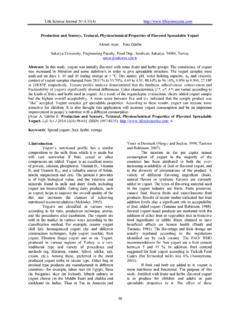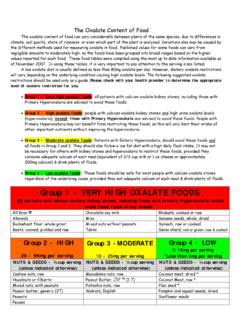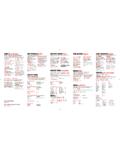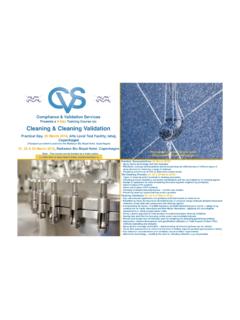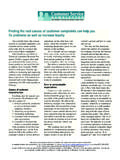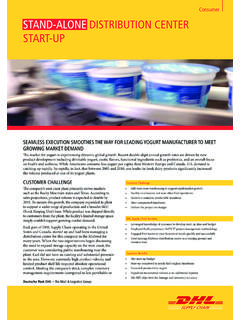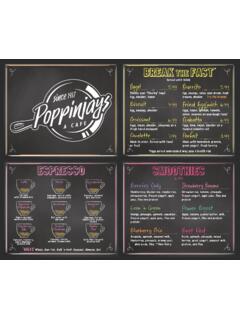Transcription of MICROBIOLOGICAL AIR QUALITY OF PROCESSING AREAS IN …
1 Brazilian Journal of Microbiology (2003) 34:255-259 ISSN 1517-8382255 MICROBIOLOGICAL AIR QUALITY OF PROCESSING AREAS IN A DAIRY PLANT ASEVALUATED BY THE SEDIMENTATION TECHNIQUE AND A ONE-STAGE AIR SAMPLERVal ria Costa Salustiano; N lio Jos Andrade*; Sebasti o C sar Cardoso Brand o;Raquel Monteiro Cordeiro Azeredo; Sandra Aparecida Kitakawa LimaDepartamento de Tecnologia de Alimentos, Universidade Federal de Vi osa, Vi osa, MG, : July 10, 2002; Returned to Authors: October 10, 2002; Approved: June 26, 2003 ABSTRACTThe MICROBIOLOGICAL air QUALITY at PROCESSING AREAS in a dairy plant was evaluated by using a one-stage airsampler, based on Andersen principles (impaction technique) and by culture settling plate technique, alsoknown as sedimentation technique.
2 Among these AREAS , milk reception, packaging, and pasteurization roomswere included. Rooms where cheese, yogurt, butter and doce de leite (Latin American typical treat madeof concentrated milk and sugar) are made were also evaluated. For all PROCESSING AREAS , the numbers ofmesophilic aerobic bacteria and yeast and molds recovered by air sampler were higher than 90 CFU m-3 themaximum value recommended by American Public Health Association (APHA). In four of the six processingareas, the microbial numbers were higher than APHA s standard (30 ) according to culturesettling plate technique. The results showed a difference (p< ) for the Staphylococcus aureus numbers(from < to UFC m-3) at PROCESSING AREAS .
3 The numbers of microorganisms recovered by impactiontechnique were about 2 to 10 times higher than by sedimentation technique. The microorganism groupdetermined at PROCESSING AREAS depended mainly on the technique. By the air sampler technique, it wasobserved the predominance of yeasts and molds and by sedimentation technique, of mesophilic aerobicbacteria. The increase of temperature at PROCESSING AREAS did not seem to affect the numbers of airbornemicroorganisms. On the other hand, the increase of air humidity showed a relation with the increase ofmicroorganism numbers. The impaction technique should be chosen since it is better to recover airbornemicroorganisms, including words: Dairy plant, air PROCESSING AREAS , MICROBIOLOGICAL QUALITY , air production the air of PROCESSING AREAS can contaminatefoods with pathogenic or spoilage microorganisms, affecting theirquality.
4 Dairy products are particularly susceptible tocontamination by airborne microorganisms . The greatest aerosolsources in dairy plants are personnel, floor drains, ventilationsystem and water, when applied under pressure in the cleaningand sanitizing procedures (1,6,15). Food contact processingsurfaces can support growth of microorganisms and become acontamination source for the aerosols formation in the airprocessing AREAS (4).Several techniques for MICROBIOLOGICAL air qualitydetermination have been developed (7,14). One of them is theair sampler technique, based on the number of microorganismsin a given air volume, suctioned by a sampler that allows therecovery of viable particles on a solid culture medium surfacesuch as the plate count agar (7).
5 An alternative procedure is thesedimentation technique as culture settling plates, based ondeposition of viable particle on the surface of a solid culturemedium per a given exposure time, as proposed by the AmericanPublic Health Association (APHA) (14).APHA recommends the following standards for aerobic platecount in the air of food PROCESSING AREAS : 90 , when*Corresponding author. Mailing address: Departamento de Tecnologia de Alimentos, Universidade Federal de Vi osa. Campus Universit rio. 36571-000,Vi osa, MG, Brasil. Tel.: (+5531) 3899-1855. Fax: (+5531) 3899-2208. E-mail: Salustiano et by the air sampler technique and 30 evaluated by the culture settling plate technique, usingplate count agar as culture medium (14)In this research, the MICROBIOLOGICAL QUALITY of the air indifferent PROCESSING AREAS of a dairy plant was evaluated usinga one-stage Andersen air sampler and the culture settling AND METHODSThe number of airborne microorganisms of milk processingareas of a dairy plant was evaluated by culture settling platetechnique and impaction technique.
6 The following AREAS wereevaluated: milk reception, packaging and pasteurization; andcheese, yogurt, butter and doce de leite PROCESSING numbers of aerobic plate count (mesophilic aerobicbacteria), yeast and molds, total coliform and Staphylococcusaureus were determined using, respectively, plate count agar(PCA), potato dextrose agar (PDA), VRB agar (VRB) and BairdParker agar (BPA), according to methods proposed by APHA(14). The experiment was conducted with a threefold repetitionfor each MICROBIOLOGICAL determination. For each repetition, 48samples were collected for each technique. The intervalsbetween the samplings were two the culture settling plate technique, open Petri dishescontaining 20 ml of culture media (PCA, PDA, VRB or BPA)were distributed at the PROCESSING AREAS and exposed for about15 to 30 minutes.
7 The Petri dishes were closed and incubated at35 C/ 48 h for aerobic plate count, 25 C/ 3-5d for yeasts andmolds, 37 C/ 48 h for and total coliform (14). Resultswere expressed as the impaction technique, volumes of 100, 500 or 1000L of airwere suctioned by an air sampler and impressed on solid mediumsurface contained on Petri dishes, according to APHA srecommendation (14). The air sampler s lid, firstly sterilized at 121 C/15 minutes, was sanitized with 70% ethyl alcohol, before and aftereach sampling. After microbial determinations, the Petri disheswere incubated in the same conditions as the culture settlingplate technique.
8 The results were expressed as of numbers of determined by impaction techniquewere corrected, as recommended by the manufacturer of thesampler, using a table based on the formula: Pr = N[1/N + 1/N-1+ 1/N-2 + 1/N-r+1], where Pr = probable number of CFU/airvolume; N = total number of lid pores (400), r = lid pores thathave already been crossed by viable particles (8).A descriptive analysis of the results was done to evaluatethe influence of humidity and temperature of the processingareas on the microorganisms numbers using a dry and wetbulbs psicrometer. Lilliefors and Cochran tests were used toevaluate the normality and uniformity of the results, averages of the log10 of the numbers of microorganisms atprocessing AREAS recovered by both techniques were comparedby Duncan test (5%).
9 RESULTST ables 1 and 2 show the microbial numbers obtained byculture settling plate and air sampler techniques. For all theprocessing AREAS in the dairy plant, the numbers of mesophilicaerobic bacteria and yeasts and molds obtained by a one-stageair sampler were higher than 90 the maximum valuerecommended by APHA for mesophilic aerobic bacteria. Bothmesophilic aerobic bacteria and yeasts and molds were higherthan APHA s standard (30 ), according to culturesettling plate technique, in four PROCESSING AREAS . The culturesettling plate technique was not able to detect coliforms and in the evaluated PROCESSING MICROBIOLOGICAL numbers in the air of the processingareas obtained by air sampler were between 10 and1310 CFU.
10 M-3 (Tables 1 and 2). There were no significantdifferences (p 0,05) for the numbers of mesophilic aerobicbacteria and yeasts and molds, among the evaluated processingareas at the dairy numbers of total coliform and S. aureus were between< and and < and , respectively. There weresignificant differences (p<0,05) among PROCESSING AREAS for thenumbers of S. aureus determined by impaction technique andanalyzed by Duncan test (Table 3) among the differentTable 1. Count range, average, and standard deviations of the numbers of yeast and molds and mesophilic aerobic bacteria asdetermined by impaction technique, at PROCESSING AREAS in a dairy QUALITY in a doiry plant257processing AREAS at the dairy plant.










